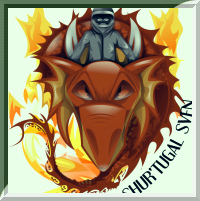
 |
|
Mount Isa and the Gulf July-September 2010
The Setting I had called this trip my Mount Isa Trip in the blog during the tour, but have added the Gulf [of Carpentaria] component to better reflect the actual route and destinations. This trip came about at the invitation of my Brisbane friends, Viki and Paul, with whom I have done all the meanders abroad, to join them for a trip to Mount Isa. Viki’s brother, Hart, had a gig going for a round Australia trip with mates on vintage bikes. The plan was to accompany them to Mount Isa and leave them to battle on westwards. Paul and Viki would return to Br I had a few other requirements on my mind before undertaking a second big trip on my new F800GS (after my Old Mail Routes trip). These were selecting the optimum time to get better dual purpose tyres on the 800GS; getting the uncomfortable F800GS seat modified; and better preparing the bike for a full-on Outback trip (e.g. relating to puncture repair). All this had been happening, but had to be accelerated. Thanks to the good service response from the Canberra (ACT, Aus) dealer, Rolfe’s, my over-worn back tyre was replaced gratis with a much improved, second hand tyre to allow more latitude in selecting the best time and situation to crossover to ‘more aggressive’ tyres. Then, Paul (Brisbane), lent on the highly recommended Brisbane-based, BMW seat modifier to squeeze my need into his busy agenda during my short sojourn. So, a day and a half in Brisbane will be filled by getting the bike’s seat re-engineered, getting some better Outback tyres fitted, and cooperatively getting the three of us prepared mentally and physically prepared for the trip. No doubt, the eve of the venture will be the time when the mental preparation comes to the fore with Paul’s and Viki’s carefully chosen wines. This is a map of the route taken and places visited. It covers about 9,000km over nine and a half weeks. You can zoom in to see more details of particular segments; and change to "Sat" to see something of the terrain. This is particularly interesting at places like Cobbald and Undara. Heading Out from Canberra With all sorts of distractions, delays and choosing to do jobs at home that really didn’t need doing, I finally got away later in the day than planned on Tuesday, 20 July 2010. I was surprised that, with the experience of my Big Trip North and so many lists, I still prevaricated indefinitely about what and how to pack. Perhaps it was the different shape and configuration of the GS. It was straight up the Federal and Hume highways and onto the M7 to the Richmond Road to get to my sister’s (Elizabeth) place for the first night. This was a chance to have a catch-up with both my sisters (the entire complement of my siblings) before the more serious plunge north. This ‘diversion’ called for a new look at getting to Brisbane post haste to accomplish the tasks ahead. It was up the Putty Road, I’d been up (and down) the Putty Road before, but this was the first time, I think, that there were several large signs warning “Motorcycle Safety Enforcement Zone”. It sounded foreboding, but, on quick analysis, as I rode by, I had to conclude I had no idea what it was meant to convey. Glenn Innes was my notional destination. But as Paul and I communicated en route about the prospects of the hoped-for seat re-engineer, I pushed onto Tenterfield to better position myself to get to Brisbane in time to ensure I could get all the planned tasks done. It was not an easy extension to the day’s trip, as the extra 80km to Tenterfield meant arriving in almost pitch dark, very cold, and no obvious town pub accommodation. In fact, the only town pub on the main street closed down five years ago, I found one on a side street. Tasks for Brisbane News from Paul was that Ergo Seats, the bike seat re-engineer, had given the ok to do my seat if it could arrive around the middle of the day. So that meant an arrival at Paul’s and Viki’s around 11.00 at the latest. It was an early rise at Tentafield. Forget breakfast. Just a cup of tea in the hotel room, pack the bike, and head out at 7.15am – 15 minutes later than my plan. Not a big deal. The bike’s computer was consistently telling me the temperature all the way to the Qld border was minus 1°C. Somewhere around the border, it jumped to 0°C and hovered between that and 1°C until Stanthorpe not far over the border into Qld. So much for ‘tropical’ Queensland! I don’t think I rode much over 80kph the whole way. Patches of fog, a misting and demisting visor, a low sun hindering visibility both forwards and back, the prospect of icy roads...all cautioned a slow and steady pace.
On arrival at Paul’s and Viki’s, Paul and I headed out to some far southern suburb of Brisbane, where I got measured for a personalised re-engineering of my bike seat. It would be ready the next day. Following a negotiation by Paul, we then went straight to Tyres for Bikes, to the north of the Brisbane centre, where we spent almost three hours discussing, debating and deciding on suitable tyres for the GS; then being taken through, in eloquent detail, the process of changing front and rear tyres. Dave was not only extremely accommodating in providing instructions but allowed me to video the proceedings. I have added this information to my page on Repairing a Puncture. Dave, who runs the Brisbane branch of Tyres for Bikes, provided sound advice, encouraging support, great service, and video flare. For the aficionados, the choice of tyres had its complications. In the end, it was a compromise or balance between expected usage (i.e. proportion of road and off-road use); views, perceptions and philosophies of tyre performance and preference; personal comfort levels; and availability of product. The outcome was to have a Mitas E09 (TT 54T) on the front and a Heidenau TL K60 on the rear. The rear tyre is a 140/80, whereas the prescribed tyre should be a 150/70. The expert advice was that the 140 (width of the tyre) would fill the rim; and the 80 (rather than 70) – a ratio of width to height – compensates for the 10mm shortage of width! Hence, a safe and well performing tyre. It was an interesting, tiring (or should that be ‘tyring’?) and productive day. With the tyres fitted, the only compulsory task next day was to collect the seat. That duly happened; and provided an opportunity to get some initial feel for riding with knobbly tyres, if only on bitumen. It was a satisfying feeling to have the bike set up with tyres designed for safer and more effective off-road travel, especially given my plan to part company with the group after Mt Isa and take on the Birdsville Track. I was more motivated to doing so now that I had the off-road or, at least, dual purpose tyres fitted. I expected the re-engineered seat would also deliver. I’d had a chance to ride with Paul’s modified seat over the couple of days in Brisbane; and it was a definite improvement on my original seat. So, after a couple of days of good eating and drinking, as always happens with Paul and Viki, we were pretty much ready for the trip. Vintage Send-Off Viki, Paul and I got away from Brisbane at about 6.15am the next day and met up with the vintage group in Toowoomba at about As scheduled, the procession of old and new bikes, together with a back-up truck and trailer, complete with a second vintage bike for Hart, set out slowly at 8,00am headed for Gaynder. Leading the line was Hart on his 1935 Harley Davidson VD twin, delivered new to its first owner the year Hart was born. Then came Keith on a 1950 500 AJS single. Keith, the senior of the group, was well established in life before his bike left the assembly line; and, indeed, before Hart’s. The third rider was Bill, the baby of the group and still in the productive work force, although confessed to continually living on the edge of long service and recreation leave entitlements owing to as many absences from work as they can support. His bike was a Norton Commando 850cc twin, appropriately the baby of the bikes at 1975 vintage. The all-important and indispensible back-up truck and trailer was driven by Robert, who was dubbed early in the trip as R1, relegating me to the title of R2. He had the patient task of driving behind the bikes displaying the back of the trailer warning ‘old and slow motorcycles ahead’. Starting the Trek We all rode together for half the day. Mostly, the vintages could chug along at about 80kph on the flat, reaching close to 90kph We made Gaynder and camped there the night. Next day was more leap-frogging between the two sets of bikes along the highway through the old gold-mining town of Mt Morgan for lunch and onto Rockhampton for the night. With dark clouds around we opted for some cabins at a local caravan park for the night. We didn’t have to ride too far from the caravan park to find a near-by grog outlet. We then settled down and watched the election debate while waiting for pizza to be delivered. Heading into North Queensland With only a couple of days on the road, we were discernibly in northern Queensland. You could feel the warmth and humidity, despite the cool mornings, gusty winds and passing showers.
Hart had been feeling the unforgiving suspension of his HD, so brought out his 1978 Yamaha XS11 for the day. His HD was relegated to the trailer. As it turned out, the Norton shredded a bolt from somewhere and had to be replaced by the HD for the remainder of the day. We (three of us) made a short diversion to St Lawrence, a stop on the northern railway line. At least, it used to be. The railway still goes through there but the railway station has been moved 100m back from the line to the main street; and has become the municipal library and community centre. Paul recalled as a 12 year old (I was discrete enough not to ask when that was) stopping there and having the train’s passengers fed substantially on the platform. No train stops there now; but the small town has a single storey, tumbling down, weatherboard hotel and a general store attached to a high galvanised iron warehouse of sorts. It looked like it might have seen grander days. Mackay was special. Viki, Paul and I stayed with Ros, a friend of ours from a few meanders abroad. I wrote about Ros in the Mackay paragraphs of my Big Trip North. My roommate from three of my four meanders abroad, Jimmy, was also there. He’d coincidentally come up from Wollongong to spend a couple weeks there helping Ros with odd jobs around the house and yard. It was a very pleasant reunion, enhanced by many of Jimmy’s beers, fine pub food, good wine, and Ros’ duty-free Baileys and Cuban cigars from a recent trip to Central America. We had a comfortably late start from Mackay and had a more interesting ride towards Ayr. While the vintages continued onto Ayr, we dropped into Bowen for lunch before rejoining the Bruce Hwy. Bowen had the recent attraction of boasting the location of the Darwin scenes in Baz Luhrmann’s Australia. We all met up again in Ayr, once again resorting to cabins, partially out of laziness and partially out of the glum skies that had accompanied us all the way up the coast. The last of the evening in Ayr introduced us to the Aurora Capricornia – in reality, the reflection on the low clouds of sugar cane burning. The phenomenon provided a glowingly red sky. (I don’t think they actually call it Aurora Capricornia, but it seemed to me to suit.) Westwards to the Outback We left the coast just short of Townsville in good time to miss heavier rain pretty much all along the Queensland coast. It wasn’t too long into the change of direction westwards that the coastal clouds drifted into our rear vision mirrors, but were being replaced by thicker and faster swirling storm clouds ahead. However, a slight sun shower and rainbow were about the limit of their efforts. As we settled into an enjoyable campground evening at Hughenden, we had a burning sunset and vague flashes of lightning on the far southern horizon.
Hughenden and Richmond, where we stopped for lunch, are in the heart of Outback Queensland’s Dinosaur area. It’s a Hughenden, Richmond, Winton triangle. I had an interesting introduction to the ages of dinosaurs when in Winton during my Big Trip North in 2009. Both Hughenden and Richmond have impressive displays of dinosaur and other fossils. The finds of dinosaur bones have been so prolific that almost complete skeletons of a particular species can be assembled, with a few substitutes of bones from other species. Other fossils are mostly sea life from the inland sea that covered most of this area. It’s hard to imagine that such a dry, relatively barren land was once an expansive inland sea. The morning in Cloncurry after a Red Claw and BBQ dinner in the camp kitchen saw a farewelling of the vintage group and their Although I had visited Cloncurry and Isa during my Big Trip North in 2009, I had been travelling in the opposite direction. It was now interesting to experience going west a similar phenomenon that I experienced going east: the relentlessly flat barren plains suddenly, with no warning, being transformed into hills and rocky outcrops, with the straight road starting to wind and twist its way through, over and around the hills. This terrain stretches both sides of Isa. We duly met up somewhat haphazardly in Isa between shopping forays. Final farewells saw the vintages head for a motorcycle shop for some urgent repairs and onto the Northern Territory
Cloncurry Having spent 3 nights in Mount Isa in 2009 and Viki and Paul having lived there many years ago, we had a quiet, relaxed afternoon with some cold beers at our camp site, followed by dinner at a nearby pub. The three of us headed back east to Cloncurry for a parting coffee, whereupon Viki and Paul headed south to Winton and onto Our ride to Cloncurry from Isa had its moment. A stray bull of considerable size had got itself trapped on a stretch of road that had safety barriers along both sides as it approached and crossed a river or creek. A cattle road train had a time getting around the bull and I ended up too far onto the approach to the bridge, leaving me, in effect, face to face with the bull, who stood his ground and eyeballed me for what seemed an eternity. I think I know what must go through the mind of a matador during those expectant minutes waiting to see what the bull’s next move will be! A 4x4 approached slowly from the opposite direction, which made the bull move further to my side of the road, whereupon I quickly retreated to the far right hand side and edged up on the wrong side of the 4x4, giving me a clear run away from the bull. I wasn’t about to become a matador!
Finally, out of the museum and coffee completed, we parted company and headed in opposite directions. Whichever direction I was to go in after the Burke and Wills Roadhouse, there would be a couple of hours ride involved to get to the roadhouse. So, with fuel and food to take on at the roadhouse, it would be too late to continue further. Besides, I was desperate for some firsthand information about the condition of the gravel roads before I ventured past points of no return. Karumba Road reports obtained later in the evening at the Burke and Wills Roadhouse suggested that most of the gravel road from Gregory Downs to Lawn Hill was in good condition as it was maintained by Century Mines, which has a large open-cut zinc mine out there. The rest was “reasonable, but corrugated.” I’d pretty much made up my mind to go that way as I finished up for the night and headed back to my tent. Next morning, I struck up a conversation with someone who had travelled the road the day before. He confirmed the reports but added that the trucks created blinding dust clouds and threw lots of stones as they roared past in the opposite direction. That gave me food for thought. I ended up ditching Lawn Hill and headed straight up the road to Normanton. Lawn Hill would have to wait another trip. Lunch in Normanton and a chat with some fellow travellers confirmed that proceeding to Karumba would be a better option than staying in Normanton. There didn’t seem to be much in Normanton to warrant a long stopover. Karumba, about 70km further on, however, is just a few hundred metres up the Norman River from the full enormity of the Gulf of Carpentaria. That in itself was enticing. Although, on first glance, there didn’t seem all that much to Karumba, a sunset cruise up the river before coming back down to the wide-open gulf itself revealed a hive of mixed activities.
The highlight of the cruise, of course, was watching the sun set across the gulf. An alternative to the cruise was to watch it from the tavern at Karumba Point on the mouth of the Norman River. The cruise option, however, had the benefit of feeling you were out in the gulf – as, indeed, you were, if only a minute fraction into this veritable sea in its own right. Then there were the kites, who get a few fish morsels thrown their way to keep them interested, and the resident osprey, with her nest and chick on one of the navigation posts that run some 7 miles into the gulf. A very pleasant evening concluded with freshly brewed coffee, more wine and hazelnut liqueur with Margaret and Norton from Cairns. They were on the cruise and we met up on the way back to the Caravan Park. We agreed that dinner was superfluous after the feast of prawns and wine we had on the cruise. They invited me to join them in their caravan for a night cap, which lead to two or three. They had stories to tell. Norton had been a captain with the Flying Doctor Service for many years, an interesting coincidence, having visited the museum to its founder in Cloncurry two days before. Margaret had been a Cairns councillor and deputy mayor for many years, so was au fait with local politics and the tourism industry (a past occupation of mine at one time in government service). I’m sure we will keep in touch. Next day, a visit to the Barramundi Hatchery was followed by a Barramundi lunch at the tavern at Karumba Point overlooking the low tide (there is only one tide a day here!) across the gulf. The plan had been to leave Karumba on Tuesday 3 August, but this was thwarted by high winds. In fact, the forceful sou’easterly turned up suddenly during the first night in Karumba – but long after the sunset cruise and evening night caps. The wind on the second night was worse, but the tent held firm even without guy ropes. The forecast next morning was for the winds to ease that night. It seemed a better option to sit out the day and wait for the calmer ‘morrow.
Tuesday was a lay day. A two-hour coffee and muffin at a thoroughly decent restaurant across from the caravan park with access to wireless internet provided an opportunity to catch up with some updates to pages on Motorcycles Meanders, such as video clips on the page on repairing a puncture. I was entertained by the corellas in their thousands. A final walk around town collected a few last minute photos. Normanton and Croydon After three nights in Karumba, I headed south back through Normanton for an hour or so before joining the Savannah Way heading east. Normanton had a few things worth taking in. The main street was adorned with a life size replica of the biggest crocodile shot anywhere in the world. It was shot in the Gulf area close to Normanton in 1957 by Krystina Pawlowski, a noted crocodile hunter of her day. Somehow the celebration of shooting what was likely to have been the oldest and biggest crocodile in the country seems incongruous in today’s world. It was almost sad that such a unique beast – 8.5 metres long metres and estimated to be over 2 ton – fell victim to a hunter’s pleasure. But they were different days back then. There are remnants of the old punt crossing that ferried people, supplies and even herds of cattle across the Norman River; there’s the Purple Pub where reputedly Neville Shute undertook research for his book A Town like Alice – and came up with the title because he thought Normanton was just that – a town like Alice. I was later told that Normanton’s famed Purple Pub had in, fact, been moved there from Croydon! The ride to Croydon was now well into Gulf Savannah country: flat, sparsely wooded with stunted trees and lots of shrubby bushes. Scrawny, ghostly Brahman cattle wandered aimlessly or lazed about near waterholes. Dusty side roads branched off to cattle stations identified by a road sign or their front gate and grid.
You won’t find this on a map. I’d never heard of it before Norton and Margaret in Karumba recommended it as a ‘must see.’ The gorge is on Cobbold Creek, a tributary of the Robertson River. It’s on private land – the 1,300 square kilometre cattle station of Robin Hood – so called because it was originally set up in the 1800s from the purchase of several old mining leases, one of which was named Sherwood. It’s about 40km SW of Forsayth, which is about 40km south of Georgetown on the Savannah Way. Getting here finally allowed me to experience my new (2,500km ago) knobbly tyres. The 80km trek in from the Savannah Way had The tour next morning – you can only visit the gorge by a tour – took you deep into the bush, across the Robertson River (down the bank, diagonally across the dry, sandy river bed and up the opposite bank), with the powerful engine of the 4x4 bus grinding painfully under the strain. Along the way was the grave of John Corbett, a property owner, who was fatally speared in 1871 by local indigenous inhabitants who presumably took exception to outsiders traipsing through their land. In fact, it seems this part of the country experienced a lot of violent incidents between Aboriginals and white settlers. The stories told retain their original slants: the shooting of 30 blacks in a retaliatory act is commemorated by the naming of the place as ‘Battle Hill’ despite the ‘battle’ being between spear-armed natives on foot and gun-carrying stockmen on horses! However, the tour had a positive and informative element of Aboriginal living, food and medicines, as we walked up the sandstone hills to the top of the escarpment overlooking the gorge.
The uniqueness of the gorge is its narrowness – down to about 2m in several places. It winds for a kilometre and a half along the creek, with its 30-40m high sandstone walls closing in on you except for the narrow slit of blue sky left visible. The boat glides imperceptibly along the deep water, slowly edging its way between outcrops and around narrow bends. The scraping of railing on rock is inevitable in places. Crocodiles lazily watch you pass, ostensibly unperturbed but probably watching suspiciously from their not quite closed eyelids. They’re fresh water crocs so not motivated or inclined to interfere with the intrusion. There was a ‘closeness’ between gorge and viewer that may well not be replicated in any other gorge. Robin Hood station was bought from its original owners by the Terry family 50 years ago. They first introduced Hereford cattle to the property, but found them totally unsuitable, succumbing to cattle ticks and the spear grass; and not taking well to the climate or food. The Brahman are different. They cope very well with the mix of conditions. Hence, the station is today stocked with Brahman, as, it would seem, are all the cattle stations in the Gulf country. Einsaleigh I was faced with two options leaving Cobbold Gorge. Both involved the 45km gravel ride from Cobbold Gorge to Forsayth. One was then to turn left at Forsayth and return to Georgetown the way I came to pick up the Savannah Way. The other was to turn right and do a loop through Einasleigh before heading back to the Savannah Way. This would be a mostly gravel route of about 160km from Cobbold Gorge. I opted for the latter. I’m yet to figure out why it is on gravel roads that the best tracks always seem to be on the wrong side of the road! The 70 or so kilometres from Forsayth to Einasleigh threw up new experiences. There were a few highly banked – fortunately with a positive camber – right hand bends with deep corrugations covered in loose gravel. There was no way you could keep the bike on the left side of the road. As it shuddered over the corrugations, it progressively slid down the bank to the lower, right hand side. Fortunately there were no on-coming vehicles. Along the way I was distracted by a small, no, tiny, movement in the middle of the road. I slowed to realise it was a kangaroo or wallaby (turned out it was a rock wallaby). I couldn’t just leave it. It was right in the middle of the road and had no idea where it was, where it was going or what was happening. Holding it in one hand, it snuggled into my chest. Sadly, its mum had been killed and lay on the edge of the road. Three vehicles in fairly quick succession had passed me going in the opposite direction about 5-10 minutes earlier. I assumed one of them had hit the mother. What do I do with this poor little mite? I first tried putting it in my jacket pocket, but its gangly legs kept getting in the way. I then hit upon my Camelbak/backpack. It sits on the top of everything on the back of the bike and is held by the shoulder straps so has no pressure over the top of it. Having found places for its contents, the little joey fitted perfectly inside. By the time I got to Einasleigh, I had thought the poor blighter might have succumbed to the constant vibrations of the corrugations. It was only later that I realised he probably didn’t even feel them. The compartment under him held the Camelbak water-filled bladder. He had been snugly lying on a water bed all the way.
“I’ve always wanted one of these”, she almost sobbed as she cuddled it affectionately. “Can I keep it?” she asked to no-one specifically. I probably usurped her dad’s prerogative by telling her she could. It didn’t take long for her dad’s reservations to be swept away by the enthusiasm and delight of his daughter. The Einasleigh pub was special. I hadn’t been there long (a lunch stop) before Robert and Charmaine and joey turned up on the quad bike. I think joey might be the talk of the town for a while. Robert did point to me at one stage and proclaimed to the three local clientele, “it’s all his fault!” Just a hundred or so metres across from the pub is a small gorge where the river has forced its way through the lava flow from Undara. It’s called Copperfield Gorge. Five kilometres into the 45km gravel road from Einasleigh to the Savannah Way, a sign warned of winding road for 40km! And it was right. Some of the adventures on this stretch were a ‘water over the road’ crossing. That was ok, except that there were several metres of water over rough rocks before the concrete ford started. There were lots of dry creek crossings over pebbly rocks. One crossing was a dog-legged, more sand than gravel bottom. That had the heart pumping! Lots of corrugation. I started to wonder whether the thought of riding gravel was a lot more appealing than the actuality of it! Finally back to bitumen and onto Mt Surprise for a break, re-fuel and re-inflate the front tyre (I had appropriately deflated it for the day’s ride). In my efforts to inflate it, I had it down to an unridable pressure before the lady came out and told me I needed to turn on the compressor. That helped! Undara Undara is not a town. It’s a volcano. Or was, 190,000 million years ago. It’s now the name given to a geological phenomenon: “one of the Earth’s longest lava flows from a single volcano in modern geological times.” So says the ‘Undara Experience’ brochure.
Hence, the phenomenon of one of the world’s longest lava flows from a single volcano in modern geological time. I did the ‘full day’ tour that took you to and around the rim of Kalkani crater; and visited every one of the tubes open to the public. These are a tiny part of what exists. The tubes are large, cavernous corridors that are now below ground level. Some run straight, some turn and disappear under ledges, only to open on the other side into more cavernous corridors. There are others that have formed into intersections and branch tunnels. Roof collapses dotted through the park have developed into mini forest groves among the mostly flat Savannah countryside. The collapses have provided more moisture to trees and provided safe habitat for the various species of wallabies that occupy the park. It’s a spectacular experience. The colours and textures of the walls and roofs display lava levels, the wide variety of mineral Next day started with a ‘bushman’s breakfast’ just far enough over a knoll from the Undara Park complex to create a remote bush setting. The ‘bushman’s breakfast’ is one of the attractions offered by the ‘Undara Experience.’ It was one of those once-only treats you should undertake during a visit. The setting was such that that you might have been on the Burke and Wills expedition. However, Burke and Wills didn’t quite have the supplies. All the preliminaries of cereal and fruit were there. A big open fire played host to the characteristically Australian ‘donkey’. That’s a mechanism that heats water. It’s a cylinder of sorts that cold water is put in an opening at the top that coveys the water to the bottom of the cylinder. As the water heats, the hot water flows or dribbles (depending on size and temperature) through an outlet at the top. This one was sized and designed to produce hot water for tea and percolated coffee. On my 2009 Big Trip North, I came across donkeys that provided hot water for the showers in remote camping spots. If you wanted a hot shower, you lit the fire and got the donkey going. Turning the shower on released cold water into the base of the donkey, pushing hot water out the top into the shower.
View of Undara National Park Here is a satellite view of the volcanic area of Undara. You can zom in to get a more detailed look at some of the main areas of interest. View Undara Volcanic Region in a larger map Innot Hot Springs Life has its hard days. This was one of those days. The enjoyable bushmen’s breakfast was followed by a lazy 100km ride to Innot Hot Springs, with a coffee, muffin and fuel stop at My Garnett, about 15km short of the hot springs. The rest of the day was spent indulging in the six or seven mineral spring pools – each of a different temperature, ranging from lobster-cooking hot to Sauvignon Blanc chilled. I did have to ride back to My Garnett to collect a cold beer and some red wine. That was the chore of the day. As the sun set, the wind, such as it was, evaporated, and the few menacing clouds that motivated me to put the fly on the tent totally disappeared. Interestingly, in the Outback – further west – the air is so dry, there is rarely a need for the fly. I slept several nights without it. Fortuitously, I used it at Innot. I was to discover that this was the first stop since leaving the coast that dew was evident. In fact, coming from about Einsaleigh and Undara must be considered the eastern edge of the Gulf Savannah region. The terrain started to change from the flat, low-lying savannah to ranges and higher altitudes. Following Innot, the next town is Ravenshoe, Queensland highest town. By then, you have well and truly left the Gulf Savannah and climbed onto the Atherton Tablelands. Ravenshoe: Interesting Times Ravenshoe was all of 30km from Innot. I’d arranged, following my change of plans at Isa, to meet up with a friend from the distant past. I was nineteen and she was eighteen when we first met. We briefly met up again a few years later, but the subsequent 44 year gap was to be patched over.
My temporary abode at Ravenshoe was an estate, Millstream Estate, a few kilometres west of Ravenshoe. The properties on the estate are all about a hectare. My host was Bob, Vietnam Veteran, ship master-certified seafarer, deep sea diver, explosives expert, accredited repairer of diving equipment, self-trained landscaper of his one hectare property and cousin of the friend I was visiting. Bob is undoubtedly a multi-talented mariner, with a long history of adventures at sea and on land. The number of times and occasions he has been on either or both ends of potentially fatal weapons (or, as he prefers to call them “attitude adjustment mechanisms”), mastering oil carriers through modern day, pirate-infected waters, being held-up in obscure ports visited for desperately needed fuels, assisting authorities in various ways – not to mention a tour in Vietnam – would provide more material than Errol Flynn ever had; and, in Bob’s case, it’s all non-fiction, if, at times, perhaps, a little embellished. His Vietnam experiences and their horrific memories still haunt him day and night. He tries to brush them off, but retells them The friend I met up with there, Bob’s cousin, is Christine. She was an 18 year old nurse at the St John of God Hospital in Ballarat, Victoria, in 1962 when I was confined there for three weeks with some vile virus. I was nineteen. While seriously committed to my studies at the local Redemptorist monastery, I was smitten with my encounter with Nurse M. While surreptitiously meeting her a few times subsequently, such meetings were always within the rules of being accompanied by a confrère. The memories stayed for years, long after deciding that the path being followed at the time was not for me. Influenced by time and reality, however, they faded; and that period of my life was eventually relegated to one’s personal, character-forming history. It must be almost two years ago, long after being introduced to Facebook by my live-in step daughter, Natalie, that I ventured back to that event of 1962; and found Christine on this ubiquitous instrument. It had never occurred to me that she wouldn’t still be 18, but the discovery that she was once again only a year younger than I probably helped sustain the intermittent communication that ensued. The current rendezvous was the outcome of a few coincidences. While the timing of our trips might have coincided, my plan, after Mt Isa, had been to head south down the Birdsville Track – frustrated only by the untimely rain that had made the track impassable in several places. That led to the option of travelling north to the Gulf to discover new territory. The rest of my trip from there is recorded above. Atherton Tablelands and Surrounds
Cairns, with its coastal heat and humidity, was a pleasant interlude to enjoying the relative coolness of the Tablelands, although dry-season Cairns is a far cry from the oppression of the wet season. Chilled Pinot Gris on the waterfront, dinner on the Esplanade and Cognacs at the hotel contributed to an enjoyable tropical evening. With a new, dual purpose Shoei helmet, we made our way back up The Gillies to the Tablelands and Ravenshoe. The Atherton Tablelands sit mostly at 700-800 metres, with Ravenshoe, Queensland’s highest town, at 920 metres. They spread behind the escarpment west of Cairns reputedly over an area the size of England and Wales combined. The tablelands include rich farming land;, lush, rolling hills; stretches of fertile agricultural flats; tracks of forest; crater lakes surrounded by the remnants of ancient rain forests; the expansive Lake Tinaroo, providing irrigation to vast spreads of sugar cane and vegetable cultivation; and, of course, the fresh, cooler retreats reminiscent of the ‘hill stations’ of former British colonies in Sri Lanka, India and Africa. Lake Tinaroo is certainly a latter day ‘hill station’. We stayed at Margaret’s and Norton’s ‘hill station’ retreat. I met them at Karumba and enjoyed a couple of latish nights in their company. Another couple of fellow Bush Tracker (a 4x4 compatible caravan) owners, John and Cheryl, were also camped here, undertaking some house-sitting duties pending the return of Marg and Norton, who, in fact, called in on us at Ravenshoe on their last leg before getting back to Tinaroo. We spent two relaxing and fun nights here in the company of new-found friends. The siting of our abode, right on the shores of the lake, which abound with birds and wildlife, such as, kangaroos, possums, bandicoots etc. , gave the stay a special dimension. It was with much reluctance that we re-packed the bike and set out for Ravenshoe. At least, the bike was a lot lighter without several bottles of wine strapped to the top of the panniers! Millstream Neighbours
Ken, a long-standing octogenarian, has seen out many decades as a stockman and cattle property owner in the far north. He has stories of droving in the Cape York Peninsula and swimming with the cattle across the Daintree River in the days before it became crowded with crocodiles. There were just a few to keep an eye out for in those days. He still lovingly cares for his retired saddle that saw him on (on off, as he recalled) many a stock horse in the unforgiving cape country. He’s become – and, possibly always was – an expert stock whip maker. His stock whips are beautifully made from carefully cut and plaited hide, with equally carefully chosen and cut wood for the handles. Ken told me that, if he didn’t keep stopping to make a cup of tea, he could complete one in two long work days. He gets orders from all over.
He’s one of those gems with so much early settlement history and bush experiences to share. Another of Bob and Carol’s Millstream Estate neighbours runs “Eagles Nest Wildlife Hospital”. It first caught my attention because of my experience with the little joey orphaned not more than 5-10 minutes before I found and rescued it between Forsayth and Einsaleigh. We dropped in there (by arrangement) and met with Harry, who set up the scheme in the early 2000s. Harry himself was as Harry’s taking in injured wildlife developed over the years into the Eagles Nest Wildlife Hospital Inc, with numerous enclosed pens and yards for wildlife that has included wedge tail eagles, a variety of raptors and other birds, dingoes, baby orphaned wallabies and kangaroos, quolls and reptiles. There is even a resident feral pig; not exactly wildlife but Oscar arrived 3½ years ago the size of a guinea pig and has become a household pet, making himself comfortable on the lounge when allowed. You couldn’t help be struck by the many yards and sheds where rats, guinea pigs and pigeons’ are bred – all essential, natural food sources for the wildlife in the ‘hospital.’ Most of the initial work in setting up the establishment and feeding and caring for the animals was done at the personal expense of Harry and his then wife – and later his partner, Karin. Becoming incorporated was an essential step to raising funds, obtaining sponsorships and, in effect, remaining viable. Harry and Karen still juggle their limited funding and intermittent donations of food with the continual delivery of injured wildlife from as far afield as the Cape and the Gulf. Harry manages logistics and, a little discordantly with his initial Germanic exterior, lovingly cares for and talks to his patients. Karin seems to have prime responsibility for nursing the several small joeys snuggled in hanging peg bags along the verandah and preparing a quarterly newsletter for their members; the latter not a bad achievement when neither have English as a first language.
The wedge tail eagle enclosure was special. The wedge tail is our largest and most spectacular bird. These magnificent creatures often fall foul of a combination of their slowness in taking off and the thoughtlessness of speeding trucks and busses that don’t allow them the time or space they need. Harry thinks he has unwittingly played cupid to a pair of his wedge tails who are busily building a nest. Time will tell. Recovered wildlife are released to the wild whenever possible. Unfortunately, several birds with broken wings – when the wings have healed awry – could never fend for themselves and so become permanent residents. In contrast to nursing injured wildlife, the ‘hospital’ property has unintentionally played host to the Mareeba Rock Wallaby, whose numbers in the area had dwindled alarmingly before the refuge was set up. They now have increased significantly by making their homes in and around the hospital’s landscaping and buildings. Farewell to Ravenshoe
This was departure time for Christine, so we said our farewells at the airport and I made the trek back up the Gillies and onto Ravenshoe. I had arranged with Ken next door to make me one of his trademark stock whips. I had already had a few lessons from him but was still struggling with the knack of cracking it safely. I got in a few more lessons on returning from Cairns. The day after returning from Cairns was crunch time. I had some sad feelings on leaving. I had been made very welcome for so long by people I had never met before; I had enjoyed a special time with someone I had not seen for over forty years. And yet, I was beginning to wish I could ‘transport’ myself back home. I hoped that, once back ‘on the road again’, I would rekindle the travelling spirit. Then a final send-off from Max the gruff, gentle giant – a cross between a Great Dane and Mastiff. Paronella Park I planned a short run from Ravenshoe. My destination was a National Park campground just off the Bruce Hwy about 60kms north of Townsville. I would have been there mid-afternoon had I not spent about 2 hours at Paronella Park!
José Paronella was a Spaniard from Catalonia who arrived near Innisfail in 1913. He made a lot of money buying, restoring and selling cane plantations. Then he set about building a dream castle; and he accomplished his dream with a grand series of buildings, which included a magnificent ballroom, acres of parklands and gardens, an ornate pavilion for enjoying refreshments and playing or watching tennis, its own hydroelectric power, reticulated water systems for fountains and fresh water – and so much more. The Paronellas’ estate was the centre of the region’s social life and a great tourism attraction. Gradually, however, it fell into decline. While José and his family survived disasters and floods, he had an internal enemy: the gravel from the river bed that he used for his cement contained mica, which rendered the cement porous and over time susceptible to crumbling. The early deaths of José and his wife didn’t help. But the final blow came with the moving of the Bruce Highway, beside which the castle was originally situated. Suddenly this grand estate was some 22kms off the main highway and its dependence, by then, on trade from passing visitors became its death knell. After many years of forgotten decline, the ruins claimed by the rain forest in the style of Angkor Wat, Mark and Judy Evans re-discovered the remnant of José Paronella’s dream in 1993. They have developed the site into today’s Paronella Park. I eventually found my destination at about 5.00pm with an ominous sky closing in. While only about 4-5 kms from the highway, the last kilometre was dirt and the camping ground damp and thick with mozzies. At least, there were facilities, if only cold showers. I made mine a quick one. I begged some mozzie repellent from another camper and set about pitching my tent and cooking dinner with my small stock of dehydrated food which I had replenished in Cairns on my return from the airport. I would not have been perturbed by the consistent rain during the night had it not been for my overlooking closing the outside flap of the fly. Mackay - again I made haste in the morning lest forecast rain return and packed up a soaking wet tent and other wet paraphernalia. The ride out was initially a concern, but the corrugated tread on the dirt road kept the water from pooling. Fortunately, I avoided the expected showers and made Mackay dry. Next day was a brilliantly sunny one, with a sea as calm as the proverbial mill pond. Ros’ house sits on a hill over-looking the sea. There is a more detailed description and photos in my Big Trip North story as I stayed with Ros last year (and together with Paul and Viki in the early part of this trip). We lunched on the harbour front and lazed around with the weekend papers. I got the tent, fly, groundsheet and various other bits dry and repacked. By coincidence, I’ve always been at Ros’ place on a Monday. Monday night is dinner-special night at the local tavern, so that’s been a compulsory visit on each occasion. For Ros it’s a nice time to catch up with friends and tradesmen – both cherished in different ways. On this occasion the pub was quieter than usual, with many of the regulars absent, but it was still a pleasant evening. Agnes Water
I got a day ahead of myself juggling itinerary and stopovers, so I’m spent a second night there. The lay day I had there was a brightly shining one, with a small gentle surf lightly rolling onto the long, curved beach, which stretches to the north towards 1770 and is bounded at the south end of the camp ground by a rocky headland. You could sit at the camp kiosk, with a decent flat white, looking across 40m or so of lawn and scattered tress to the beach and the low tide surf, the murmur of the breakers being the only background noise. If I could have been sure of the weather, it wouldn’t have been hard to stay on; but I had a couple of visits scheduled before spending the weekend with Kev, Bec and granddaughter Brodee. The Run Home I had been reluctant to leave Agnes Water – so reluctant that I didn’t get away until 11.30am. That meant a bit of making up time to get to Caloundra at a decent hour. I was heading for Joe and Marg’s, friends I have ridden with on BMW safaris and Ulysses AGMs. Joe was away, but Marg and I had a very pleasant evening with an appropriate amount of good wine. They have a spectacular house on one of the tidal canals at the back of the Caloundra coastal spread.
The weekend with family was a treat. Brodee exploited her ‘grandpa’ to the full by engaging him in every game she could devise. Kev got to work on cleaning his dad’s bike, albeit with the latter’s co-opted assistance. Bec enjoyed the opportunity to sit back and quaffed some wines. Bella, the under-sized Staffie, relished in the added attention. Setting out from Springfield Lakes, south west of Brisbane, I had in mind reaching Warialda – along the middle route I prefer to take between home and Kev and Bec’s. It was a leisurely 9.00am start with a diversion to Toowoomba to call in on friends Val and Dick from Gympie, who are staying with their daughter to facilitate Dick’s need for a series of radiotherapy. Their granddaughter, Louise, a new mum, who happened to be visiting when I called, has already made a significant mark on the local musical scene with lead roles including The King and I and Cats. Val and Dick are doing it tough at the moment. Despite the start time and a 45mins stop in Toowoomba, I managed >600km, pushing beyond Warialda to the next town, then the next and the next! Pulling in at 5.30pm in Manilla was much later than my preferred time of 4.00pm, but the temptation to position myself for a one-day home run was too much. The publican at the Post Office Hotel in Manilla was something. Despite my being a paying guest with powerpoints and heters in my room, he took inexplicable exception to my use of a spare power point in the bar for my mini-laptop. He ranted irrationally about it for the rest of the evening. I think, despite the hospitality and good cooking of his wife, the PO hotel in Manilla might be a good pub to avoid. My ambition and expectation to do a one-day dash from Manilla to home looked shaky at the outset. The forecast rain or, at least, some of it had passed over during the night. The early morning, however, was eerie. A massive, low, black cloud was slowly drifting over town like the huge space craft from Independence Day. Its shadow alone was enough to inspire a delayed departure. I was consoled by the fact that it was heading north east; and I was about to head more or less south west. I was away by 7.00am and made good time on mostly dry roads. My plan was fully on track for most of the day. With time available, I made a brief detour to a cattle and sheep station at Coolah. The owners are cousins of Norton and Margaret whom I met in Karumba and Tinaroo Dam.
All stayed well until the road between Wellington and Molong when the heavens finally let loose with all their force. Driving rain and lack of light ironically made it too dangerous to stop, so Molong was painfully reached soaking wet and bitterly cold. I pushed on in hope that the rain, which has eased by Molong, might stay away. However, with more to come, I called a wise halt to the trip for a night at Cowra. The last day was a dry, sunny but cold run to Canberra. The trip was nine and a half weeks (nothing to do with the movie of that name)! That’s just a few days fewer than My Big Trip North last year. But it was about 5,000km fewer, no doubt owing to a three-week stop-over in Ravenshoe.
|
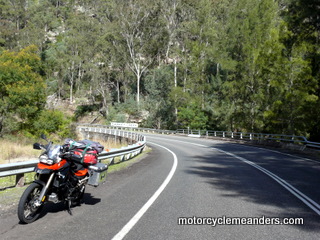 renowned as a motorcycle magnet, and a good introduction to coping with a heavily laden bike in posted ‘motorcycle dangerous’ territory.
renowned as a motorcycle magnet, and a good introduction to coping with a heavily laden bike in posted ‘motorcycle dangerous’ territory. 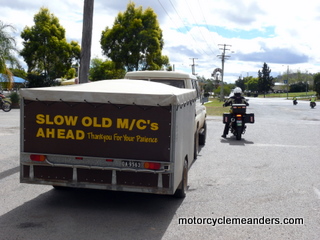 downhill. Not that they did their calculations in kilometres; all their measurements related to miles. The non-vintage bikes eventually moved ahead for periods, pulling in for fuel or coffee and waiting for the vintages to catch up. It was a good pattern that provided flexibility and camaraderie.
downhill. Not that they did their calculations in kilometres; all their measurements related to miles. The non-vintage bikes eventually moved ahead for periods, pulling in for fuel or coffee and waiting for the vintages to catch up. It was a good pattern that provided flexibility and camaraderie.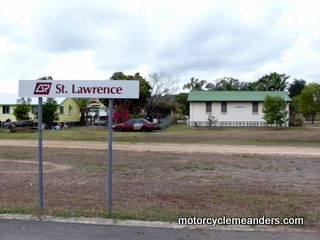 The run from Rocky to Mackay was uneventful. The Bruce Hwy has several, long straight stretches broken at times by almost straight-arm elbow bends. The terrain morphed from flat, sparsely treed grazing land to sugar cane plantations, with successive towns hosting sugar cane processing plants force-feeding plumes of smoke into the air, looking like the folds of skin around the face and neck of a Shar-Pei. It’s peak sugar cane harvesting time. The stench of molasses hung lazily in the air.
The run from Rocky to Mackay was uneventful. The Bruce Hwy has several, long straight stretches broken at times by almost straight-arm elbow bends. The terrain morphed from flat, sparsely treed grazing land to sugar cane plantations, with successive towns hosting sugar cane processing plants force-feeding plumes of smoke into the air, looking like the folds of skin around the face and neck of a Shar-Pei. It’s peak sugar cane harvesting time. The stench of molasses hung lazily in the air.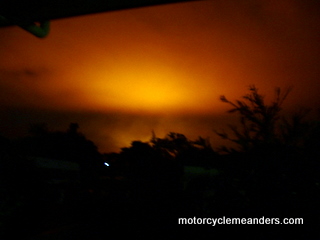
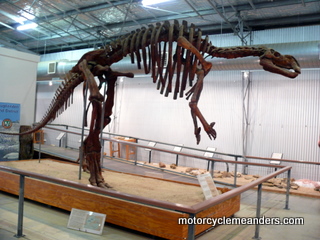 Inland Queensland was experiencing temperatures well above average for the time of year. We rode from Hughenden with the temperatures up to 34°C. The road was mostly straight. I had the GPS on the mode that featured a large compass, not unlike a ship’s that fluctuated so that your direction was always at the top of the compass; and the direction in compass degrees was illustrated in a small digital screen. It was reminiscent of being at the helm of HMB Endeavour on my
Inland Queensland was experiencing temperatures well above average for the time of year. We rode from Hughenden with the temperatures up to 34°C. The road was mostly straight. I had the GPS on the mode that featured a large compass, not unlike a ship’s that fluctuated so that your direction was always at the top of the compass; and the direction in compass degrees was illustrated in a small digital screen. It was reminiscent of being at the helm of HMB Endeavour on my 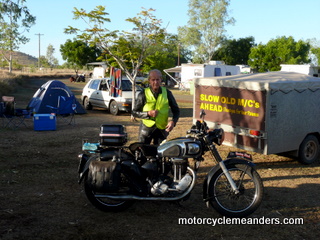 support vehicle. Although we would all head for Mt Isa, Viki, Paul and I would spend a night there while the vintages would continue to Cammoweal on the Qld/NT border. We figured we would probably catch up in the Isa as both groups had some shopping to do, but just in case that didn’t happen, we engaged in formal farewells and goodlucks.
support vehicle. Although we would all head for Mt Isa, Viki, Paul and I would spend a night there while the vintages would continue to Cammoweal on the Qld/NT border. We figured we would probably catch up in the Isa as both groups had some shopping to do, but just in case that didn’t happen, we engaged in formal farewells and goodlucks.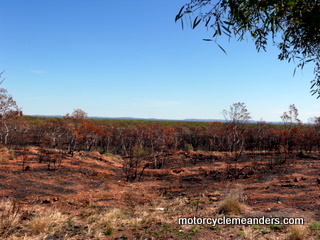 Brisbane eventually; and I set out north along the Matilda Hwy but still uncertain what turn to take after the Burke and Wills Roadhouse 182km up the road from Cloncurry. Hence I decided to camp the night there.
Brisbane eventually; and I set out north along the Matilda Hwy but still uncertain what turn to take after the Burke and Wills Roadhouse 182km up the road from Cloncurry. Hence I decided to camp the night there.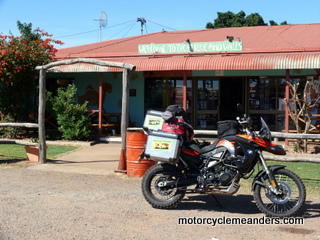 Cloncurry had an attraction that I had missed in 2009: a permanent display/museum devoted to John Flynn, noted for his work bring services to th
Cloncurry had an attraction that I had missed in 2009: a permanent display/museum devoted to John Flynn, noted for his work bring services to th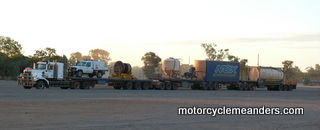
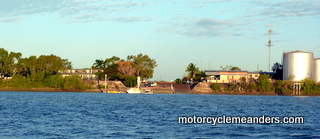 Sprawled along the river upstream from the small town were piers, boats and ships used for loading live cattle for overseas markets, the comings and goings of prawn and fish trawlers, the dewatering and loading of zinc from the Century mine (the zinc is conveyed via a 304km underground slurry pipeline to the dewatering plant and port in Karumba), a Barramundi hatchery that restocks the local rivers and dams, and many vestiges of Karumba’s past history. Even the boat ramp from which we departed had its role in the past.
Sprawled along the river upstream from the small town were piers, boats and ships used for loading live cattle for overseas markets, the comings and goings of prawn and fish trawlers, the dewatering and loading of zinc from the Century mine (the zinc is conveyed via a 304km underground slurry pipeline to the dewatering plant and port in Karumba), a Barramundi hatchery that restocks the local rivers and dams, and many vestiges of Karumba’s past history. Even the boat ramp from which we departed had its role in the past. 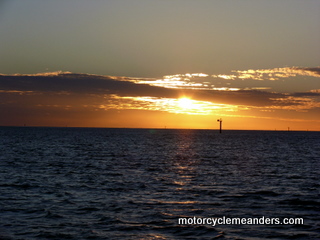
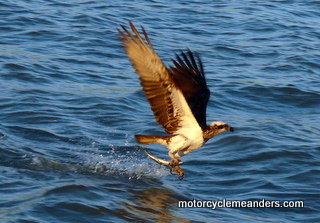 My ’quiet day’ on the Monday had another enjoyable conclusion; this time joining Margaret and Norton and their travelling friends, Alan and Jenny, in a game of Gin Rummy of sorts – played with small tiles and a few rule variations; and a night cap!.
My ’quiet day’ on the Monday had another enjoyable conclusion; this time joining Margaret and Norton and their travelling friends, Alan and Jenny, in a game of Gin Rummy of sorts – played with small tiles and a few rule variations; and a night cap!. 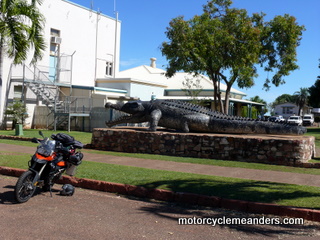
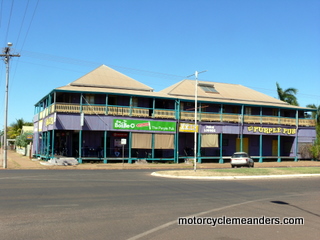 Croydon might have been a town simply ridden through were it not for the need to time my arrival at Cobbold Gorge, where I had booked a tour. Having arrived at Croydon by lunch time, I discovered a town with a glorious past – as with so many now forgotten towns. It was a centre of gold mining. Gold was first discovered there in January 1886; and by August, it had over 8,000 people. At one time, Croydon had four undertakers (scarcity of water caused many diseases), more than 122 liquor licences in the gold fields and 36 hotels in the town. Today, there’s only 300 people who share the town with remnants of gold-mining machinery; impressive heritage buildings that were once the police station, police officer’s residence, courthouse, and a ward of the original hospital; one solitary pub; and a half dozen cemeteries.
Croydon might have been a town simply ridden through were it not for the need to time my arrival at Cobbold Gorge, where I had booked a tour. Having arrived at Croydon by lunch time, I discovered a town with a glorious past – as with so many now forgotten towns. It was a centre of gold mining. Gold was first discovered there in January 1886; and by August, it had over 8,000 people. At one time, Croydon had four undertakers (scarcity of water caused many diseases), more than 122 liquor licences in the gold fields and 36 hotels in the town. Today, there’s only 300 people who share the town with remnants of gold-mining machinery; impressive heritage buildings that were once the police station, police officer’s residence, courthouse, and a ward of the original hospital; one solitary pub; and a half dozen cemeteries. 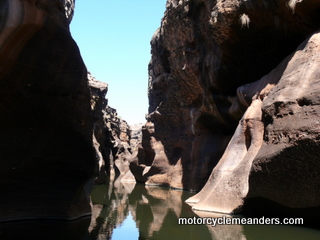 about 60km of recently graded gravel. ‘Recently graded’ means that the corrugations have been eliminated or substantially reduced; but, in reality, transformed to lots of loose gravel waiting to be re-corrugated by passing traffic.
about 60km of recently graded gravel. ‘Recently graded’ means that the corrugations have been eliminated or substantially reduced; but, in reality, transformed to lots of loose gravel waiting to be re-corrugated by passing traffic.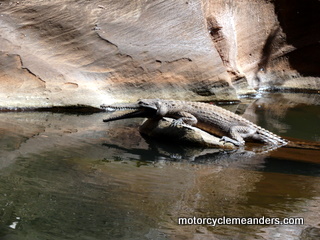 The centrepiece, of course, was the gorge. Having viewed it from the escarpment, we went down to the banks of Cobbold Creek and went into the gorge by flat-bottom aluminium boats – about 1.5m wide and driven by small, soundless, outboard, electric motors.
The centrepiece, of course, was the gorge. Having viewed it from the escarpment, we went down to the banks of Cobbold Creek and went into the gorge by flat-bottom aluminium boats – about 1.5m wide and driven by small, soundless, outboard, electric motors.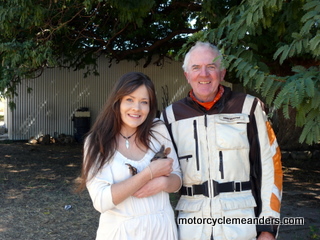
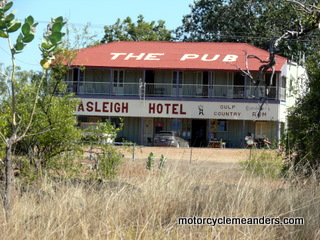
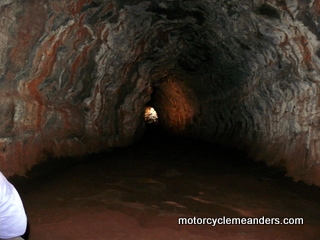
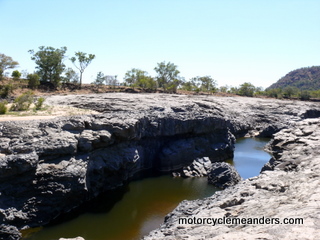
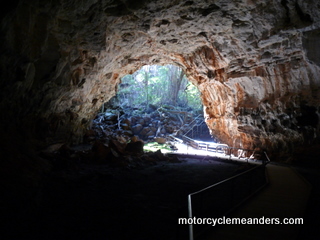 content in the lava, and the interaction of lava, the lava tubes and the surrounding countryside. The tubes are also home to many species of micro bats and other cave dwellers.
content in the lava, and the interaction of lava, the lava tubes and the surrounding countryside. The tubes are also home to many species of micro bats and other cave dwellers.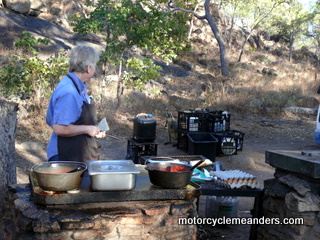 A
A 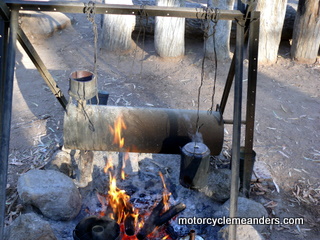
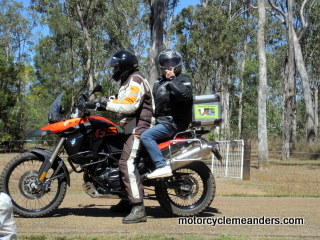 I figured I’d likely spend a few days at Ravenshoe. Besides enjoying a reunion – we were both anticipating some long chats over select red wines – I had a few housekeeping tasks to do in Cairns. A new helmet was top of the list. My helmet had fallen off the bike one time too many in Karumba and smashed the visa mechanism. I had the visa stuck on with ducting tape but it was unopenable, so I’d had 4-5 days of riding with no ability to get access to fresh air or put sunglasses on.
I figured I’d likely spend a few days at Ravenshoe. Besides enjoying a reunion – we were both anticipating some long chats over select red wines – I had a few housekeeping tasks to do in Cairns. A new helmet was top of the list. My helmet had fallen off the bike one time too many in Karumba and smashed the visa mechanism. I had the visa stuck on with ducting tape but it was unopenable, so I’d had 4-5 days of riding with no ability to get access to fresh air or put sunglasses on.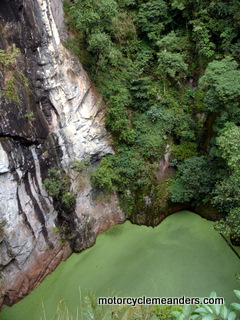 with stark and vivid reality. As with his other experiences and involvements, past and current, his representations of them are presented in a unique and characteristic way, with a turn of phrase that, while beguilingly humorous , belies a deeper anxiety that will likely needle him always. His absolute irreverence for authority, civil, political, military and judicial, is just a part of his complex, enticing and respected persona. Underlying it is a well-informed, astute and insightful political scientist, philosopher and military strategist, albeit with a language that might not be acceptable for academia or print.
with stark and vivid reality. As with his other experiences and involvements, past and current, his representations of them are presented in a unique and characteristic way, with a turn of phrase that, while beguilingly humorous , belies a deeper anxiety that will likely needle him always. His absolute irreverence for authority, civil, political, military and judicial, is just a part of his complex, enticing and respected persona. Underlying it is a well-informed, astute and insightful political scientist, philosopher and military strategist, albeit with a language that might not be acceptable for academia or print.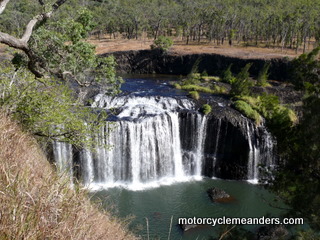 Time spent in Millstream Estate included numerous cups of tea with Christine, Bob and his housemate and close friend, Carol, while chatting and listening to Bob’s stories. I took my turn at cooking dinner – much to the resentment and disgust of Carol who abhors having a man in her kitchen; but she’s learning to cope with it! Christine and I have also had a couple of side trips. Bob insisted we take his Nissan Patrol to go to Atherton. I felt I was driving a Centurion tank! That trip included a visit to Mt Hypipamee – a large ‘blow hole’ of sorts brought about by an ancient volcano’s high pressure gases smashing through the Earth’s thick rock crust. A second side trip took us by bike to Mt Garnett and a splurge in the Innot Hot Springs.
Time spent in Millstream Estate included numerous cups of tea with Christine, Bob and his housemate and close friend, Carol, while chatting and listening to Bob’s stories. I took my turn at cooking dinner – much to the resentment and disgust of Carol who abhors having a man in her kitchen; but she’s learning to cope with it! Christine and I have also had a couple of side trips. Bob insisted we take his Nissan Patrol to go to Atherton. I felt I was driving a Centurion tank! That trip included a visit to Mt Hypipamee – a large ‘blow hole’ of sorts brought about by an ancient volcano’s high pressure gases smashing through the Earth’s thick rock crust. A second side trip took us by bike to Mt Garnett and a splurge in the Innot Hot Springs.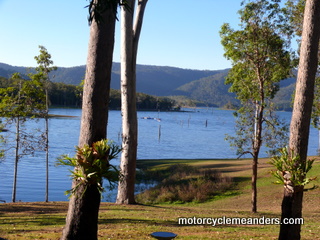
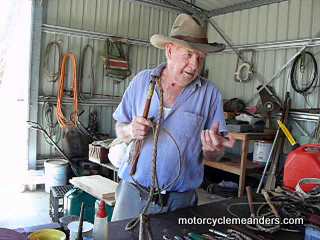 On the next door Hectare plot to where I stayed lives Ken.
On the next door Hectare plot to where I stayed lives Ken. 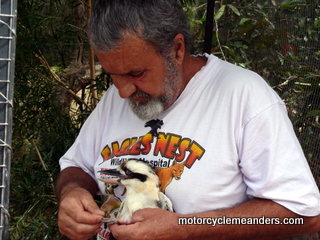 interesting as his achievements with and continuing commitment to wildlife care.
interesting as his achievements with and continuing commitment to wildlife care. 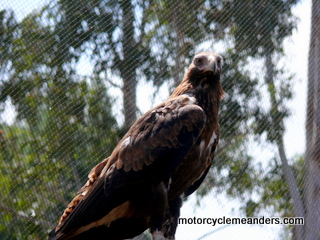 Harry lamented that his quoll enclosure, usually with a few new occupants a year, hasn’t had an inmate all this year. He puts this down to the dwindling number of quolls in the wild, falling victim to feral cats and intolerant householders. He has a similar situation with dingoes, his only dingo currently being one that had become too domesticated to safely release back into the wild. Sadly, according to Harry, the dingo has too often been pilloried as a pest rather than recognised and accepted as part of our native wildlife.
Harry lamented that his quoll enclosure, usually with a few new occupants a year, hasn’t had an inmate all this year. He puts this down to the dwindling number of quolls in the wild, falling victim to feral cats and intolerant householders. He has a similar situation with dingoes, his only dingo currently being one that had become too domesticated to safely release back into the wild. Sadly, according to Harry, the dingo has too often been pilloried as a pest rather than recognised and accepted as part of our native wildlife. 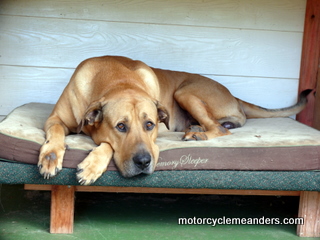
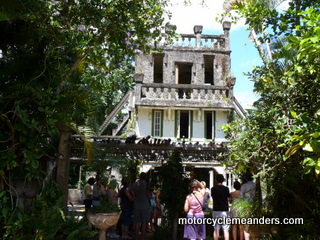 Paronella Park is
Paronella Park is 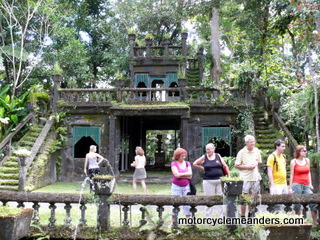
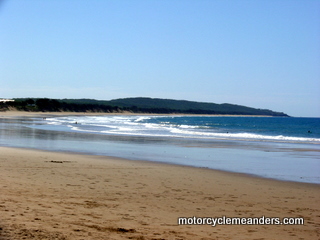 Contrary to my reading of the forecasts and weather maps, it was bleak and wet on setting out from Mackay, so the day’s journey south started in wet-weather gear. Fortunately the rain was light and petered out after about an hour and a half, making way for a dry road and, finally, sunshine. I’d brought only a camping spray jacket and old rain pants; the latter, despite the light rain, not protecting me from the inevitable wet crotch.
Contrary to my reading of the forecasts and weather maps, it was bleak and wet on setting out from Mackay, so the day’s journey south started in wet-weather gear. Fortunately the rain was light and petered out after about an hour and a half, making way for a dry road and, finally, sunshine. I’d brought only a camping spray jacket and old rain pants; the latter, despite the light rain, not protecting me from the inevitable wet crotch. 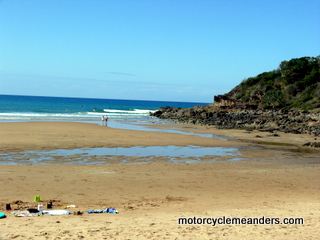
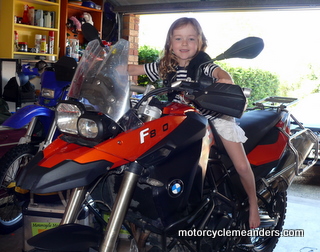 With rain in the offing, it was a short ride to Springfield Lakes to spend some time with Kev, Bec and Brodee (son, DIL and granddaughter). First stop was a lunch call on friend Marj. Coincidentally, it was Marj’s 87th birthday, so we had an impromptu birthday lunch. The routine – over several visits – is to call by the local shops and pick up some rolls, ham, tomato etc for lunch. Since Marj is prett
With rain in the offing, it was a short ride to Springfield Lakes to spend some time with Kev, Bec and Brodee (son, DIL and granddaughter). First stop was a lunch call on friend Marj. Coincidentally, it was Marj’s 87th birthday, so we had an impromptu birthday lunch. The routine – over several visits – is to call by the local shops and pick up some rolls, ham, tomato etc for lunch. Since Marj is prett